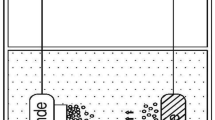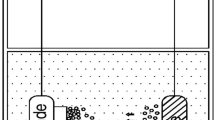Abstract
A nanoporous structure was fabricated on the surface of a copper block by electrodeposition and heat treatment compound technology. The influence of the heat treatment parameters on the binding force of a structure was analyzed, and a platform was set up to test the pool boiling heat transfer performance. By observing the SEM morphology, the effect of electrodeposition parameters on the formation of nanoporous structure was determined, and the heat transfer coefficient and wall superheat between different surfaces were compared. At the same time, by means of visualization, the bubble behavior of a smooth surface and a nanoporous surface under different heat fluxes was studied. The results show that the surface structure of nanoporous copper prepared by electrodeposition and heat treatment can improve the bonding strength by 77 %, decrease the wall superheat by 45 %, and increase the heat transfer coefficient by 80 %.









Similar content being viewed by others
References
Wiesche SAD, Bardas U, Uhkötter S (2011) Boiling heat transfer on large diamond and SiC heaters: the influence of thermal wall properties. Int J Heat Mass Transf 54:1886–1895
Chu KH, Enright R, Wang EN (2012) Structured surfaces for enhanced pool boiling heat transfer. J Appl Phys Lett 100(24):241–603
Tang Y, Lu LS, Yuan D, Su DS (2008) Micro-column enhanced boiling structure and its ramification. J Cent South Univ 15(s2):222–227
Yang YP, Ji XB, Xu JL (2012) Pool boiling heat transfer on copper foam covers with water as working fluid. Int J Therm Sci 49(7):1227–1237
Ji WT, Qu ZG, Li ZY, Guo JF, Zhang DC, Tao WQ (2011) Pool boiling heat transfer of R134a on single horizontal tube surfaces sintered with open-celled copper foam. Int J Therm Sci 50(11):2248–2255
Li SH, Furberg R, Toprak MS, Palm B, Muhammed M (2008) Nature-inspired boiling enhancement by novel nanostructured macroporous Surfaces. J Adv Funct Mater 18(15):2215–2220
Ei-genk MS, Ali AF (2010) Enhancement of saturation boiling of PF-5060 on microporous copper dendrite surfaces. ASME J Heat Transf 132(7):71501-1–71501-9
Chen RK, Lu MC, Srinivasan V, Wang ZJ, Cho HH, Majumdar A (2009) Nanowires for enhanced boiling heat transfer. J Nano Lett 9(2):548–553
Tang Y, Tang B, Li Q, Qing JB, Lu LS, Chen KP (2013) Pool-boiling enhancement by novel metallic nanoporous surface. J Exp Thermal Fluid Sci 44:194–198
Vemuri S, Kim KJ (2005) Pool boiling of saturated FC-72 on nano-porous surface. Int Commun Heat Mass Transf 32(1):27–31
Sesen M, Khudhayer W, Karabacak T, Kosar A (2010) Compact nanostructure integrated pool boiler for microscale cooling applications. J Micro Nano Lett 5(4):203–206
Forrest E, Williamson E, Buongiorno J, Hu LW, Rubner M, Cohen R (2010) Augmentation of nucleate boiling heat transfer and critical heat flux using nanoparticle thin-film coatings. Int J Heat Mass Transf 53(1):58–67
Patil CM, Kandlikar SG (2014) Pool boiling enhancement through microporous coatings selectively electrodeposited on fin tops of open microchannels. Int J Heat Mass Transf 79:816–828
Patil CM, Santhanam KSV, Kandlikar SG (2014) Development of two-step electrodeposition process for enhancing pool boiling. Int J Heat Mass Transf 79:989–1001
Cheng IC, Hodge AM (2012) Morphology, oxidation, and mechanical behavior of nanoporous Cu foams. J Adv Eng Mater 14(4):219–226
Phan HT, Caney N, Marty P, Colasson S, Gavillet J (2009) Surface wettability control by nanocoating: the effects on pool boiling heat transfer and nucleation mechanism. Int J Heat Mass Transf 52(23–24):5459–5471
Biener J, Wittstock A, Baumann TF, Weissmüller J, Bäumer M, Hamza AV (2009) Surface chemistry in nanoscale materials. J Mater 2(4):2404–2428
Kline SJ (1985) The purposes of uncertainty analysis. ASME J Fluids Eng 107(2):153–160
Lee CY, Bhyiya MMH, Kim KJ (2010) Pool boiling heat transfer with nanoporous surface. Int J Heat Mass Transf 53(19):4274–4279
Chien LH, Webb RL (1998) Measurement of bubble dynamics on an enhanced boiling surface. J Exp Thermal Fluid Sci 16(3):177–186
Tang T (2015) The manufacture of nanoporous copper surface structure and its pool boiling enhancement performance. South China University of Technology, Guangzhou
Tang B (2013) Study on manufacturing and boiling heat transfer performance of nanoporous copper surface. South China University of Technology, Guangzhou
Li C, Wang ZK, Wang P, Peles Y, Koratkar N, Peterson GP (2008) Nanostructured copper interfaces for enhanced boiling. Small 4(8):1084–1088
Polezhaev YV, Kovalev SA (1990) Modelling heat transfer with boiling on porous structures. J Thermal Eng 37(12):617–621
Haramura Y, Katto Y (1983) A new hydrodynamic model of critical heat flux, applicable widely to both pool and forced convection boiling on submerged bodies in saturated liquids. Int J Heat Mass Transf 26(3):389–399
Theofanous TG, Dinh TN, Tu JP, Dinh AT (2002) The boiling crisis phenomenon: part II: dryout dynamics and burnout. J Exp Thermal Fluid Sci 26(6):793–810
Acknowledgments
This work is financially supported by the Key Program of NSFC Guangdong Joint Funds of China (No. U1401249), the National Natural Science Foundation of China (Nos. 51375175, and 51405165) and the Natural Science Foundation of Guangdong (Nos. 2015A030313201, and 2014A030312017). The authors also thank to the Pearl River S&T Nova Program of Guangzhou and the Fundamental Research Funds for the Central Universities.
Author information
Authors and Affiliations
Corresponding author
Rights and permissions
About this article
Cite this article
Gao, J., Lu, LS., Sun, JW. et al. Enhanced boiling performance of a nanoporous copper surface by electrodeposition and heat treatment. Heat Mass Transfer 53, 947–958 (2017). https://doi.org/10.1007/s00231-016-1868-4
Received:
Accepted:
Published:
Issue Date:
DOI: https://doi.org/10.1007/s00231-016-1868-4




